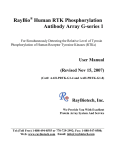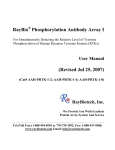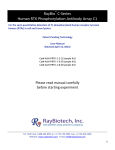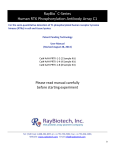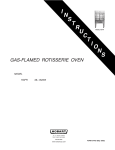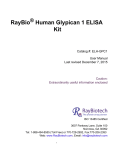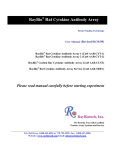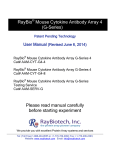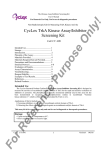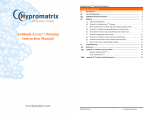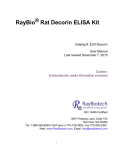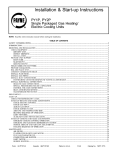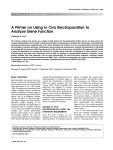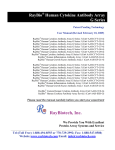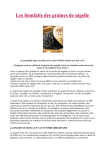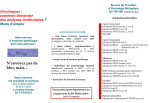Download Manual - RayBiotech, Inc.
Transcript
RayBio® Human RTK Phosphorylation Antibody Array G-series 1 For Simultaneously Detecting the Relative Level of Tyrosin Phosphorylation of Human Receptor Tyrosine Kinases (RTKs) User Manual (Revised Mar 12, 2008) (Cat#: AAH-PRTK-G1-4 and AAH-PRTK-G1-8) RayBiotech, Inc. We Provide You With Excellent Protein Array System And Service Tel:(Toll Free) 1-888-494-8555 or 770-729-2992; Fax: 1-888-547-0580; Web: www.raybiotech.com Email: [email protected] RayBiotech, Inc. RayBio® Huamn RTK Phosphorylation Antibody Array G-series 1 Protocol TABLE OF CONTENTS I. Introduction……..……………………………... 2 How It Works………………..………………… 3 II. Materials Provided…………………………….. 4 III. Additional Materials Required………………… 5 IV. Reagent Preparation……………………………. 5 V. Overview and General Considerations………… 7 A.Preparation of Samples……………………… 7 B. Handling Glass Chips……..…………..…….. 8 C. Incubation…………………………………… 8 VI. Protocol………………………………………… 9 A. Dry the Array Chips…………………………. 9 B. Blocking and Incubation…………………….. 9 C. Fluorescence Detection……………………… 13 VII. Interpretation of Results……………………….. 14 VIII.Troubleshooting Guide………………………… 16 IX. Reference List…………………………………. 17 1 RayBio® Human RTK Phosphorylation Antibody Array G-series 1 Protocol I. Introduction Protein phosphorylation plays an unusually prominent role in cell signaling, development and growth. The RayBio® Human RTK Phosphorylation Antibody Array G-series 1 is a very rapid, convenient and sensitive assay to simultaneous detect multiple protein phosphorylations and can be used to monitor activation or function of important biological pathways. RayBiotech is committed to developing a series of phosphorylation antibody arrays. Our first product in this series is RayBio® Human RTK Phosphorylation Antibody Array 1 which is specifically designed for simultaneously identifying the relative levels of phosphorylation of 71 different Human Receptor Tyrosine Kinases (RTKs) in cell lysate. By monitoring the changes in protein tyrosine phosphorylation in your experimental model system, you can verify pathway activation in your cell lines without spending excess time and effort in performing an analysis of immunoprecipitation and/or Western Blot. To use the RayBio® Human RTK Phosphorylation Antibody Array G-series 1, treated or untreated cell lysate is added into antibody array glass chip. The antibody array chips are washed and biotinylated anti-phosphotyrosine antibodies are used to detect phosphorylated tyrosines on activated receptors. After incubation with Fluorescent dye-Conjugated Streptavidin (cy3 equivalent), image the signals using laser scanner, such as the Axon GenePix, using the cy3 channel. 2 RayBio® Human RTK Phosphorylation Antibody Array G-series 1 Protocol Here’s how it works + Sample Antibody array chips Incubation of Sample with arrayed antibody chips 2 hrs Biotinylated antiPhosphotyrosine Incubation with Biotinylated anti-Phosphotyrosine LabeledStreptavidin Incubation with labeled Streptavidin Data analysis and graph 3 RayBio® Human RTK Phosphorylation Antibody Array G-series 1 Protocol 2 hrs 2 hrs II. Materials Provided Upon receipt, the kit should be stored at –20 °C to -80 °C. Please use within 6 months from the date of shipment. After initial use 2X Cell Lysis Buffer, Blocking Buffer, 20X Wash Buffer I, 20X Wash Buffer II, Biotin-Conjugated Anti-phosphotyrosine and Fluorescent dye-Conjugated Streptavidin (cy3 equivalent) should be stored at 4 °C to avoid repeated freeze-thaw cycles. Array I Glass Chip, Protease Inhibitor Cocktail and Phosphatase Inhibitor Cocktail Set II should be kept at –20 ° to -80°C. Use within three months after initial use. • RayBio® Human RTK Phosphorylation Antibody Array Gseries 1 Glass Chip with Frame (each slide with 4 Subarrays, 1 slide for 4 subarray chips, and 2 for 8 subarray chips) • 2X Cell Lysis Buffer (5 ml) • Protease Inhibitor Cocktail (1/2 tubes, 1 tube for 4-subarrary chips, and 2 for 8-subarray chips) • Phosphatase Inhibitor Cocktail Set II (1/2 tubes, 1 tube for 4subarrary chips, and 2 for 8-subarray chips) • Blocking Buffer (8 ml) • 20X Wash Buffer I (30ml) • 20X Wash Buffer II (30ml) • Biotin-Conjugated Anti-phosphotyrosine (1/2 tubes, 1 tube for 4-subarrary chips, and 2 for 8-subarray chips) • Fluorescent dye-Conjugated Streptavidin (cy3 equivalent) (1/2 tubes, 1 tube for 4-subarrary chips, and 2 for 8-subarray chips) • Wash Buffer III (20 ml) • Adhesive film 4 RayBio® Human RTK Phosphorylation Antibody Array G-series 1 Protocol III. Additional Materials Required • • • • • • • Shaker Laser scanner for fluorescence detection Aluminum foil Distilled water Plastic box 50 ml Centrifuge tube Isopropanol (2-propanol) Layout of Array Glass Chip Array Blank Barcode 4 arrays in one glass chip IV. Reagent Preparation. 1. Protease Inhibitor Cocktail: Briefly spin down the Protease Inhibitor Cocktail tube before use. Add 60 µl of 1x Lysis Buffer into the vial to prepare a 100X Protease Inhibitor Cocktail. 5 RayBio® Human RTK Phosphorylation Antibody Array G-series 1 Protocol 2. Phosphatase Inhibitor Cocktail Set II: Briefly spin down the Phosphatase Inhibitor Cocktail Set II tube before use. Add 180 µl of 1X Lysis Buffer into the vial to prepare 25X Phosphatase Inhibitor Cocktail Set II Concentrate. Dissolve the powder thoroughly by a gentle mix. 3. 2X Cell Lysis Buffer: Cell lysis buffer should be diluted 2-fold with deionized or distilled water. Add 20 µl of Protease Inhibitor Cocktail Concentrate and 80 µl of Phosphatase Inhibitor Cocktail Set II Concentrate into 1.9 ml of 1X Lysis Buffer before use. Mix well. 4. 20X Washing Buffer I or II : If the 20X Wash Concentrate contains visible crystals, warm to room temperature and mix gently until dissolved. Dilute 25 ml of Wash Buffer Concentrate into deionized or distilled water to yield 500 ml of 1X Wash Buffer. 5. Biotinylated anti-Phosphotyrosine: Briefly spin the Detection Antibody tube before use. Add 65 µl of Blocking Buffer into the tube to prepare a Biotinylated Anti-phosphotyrosine Concentrate. Pipette up and down to mix gently (the concentrate can be stored at 40C for 5 days). Add 30 µl of Detection Antibody Concentrate into a tube with 570 µl of Blocking Buffer. Mix gently to prepare 1X Biotinylated Anti-phosphotyrosine. 6. Fluorescent dye-Conjugated Streptavidin (cy3 equivalent): briefly spin the Fluorescent dye-Conjugated Streptavidin before use. Add 50 µl of Blocking Buffer into the tube to prepare a Streptavidin Concentrate. Pipette up and down to mix gently. Add 10 µl of Streptavidin Concentrate into a tube with 1 ml of Blocking Buffer. Mix gently to prepare 1X Streptavidin solution. 6 RayBio® Human RTK Phosphorylation Antibody Array G-series 1 Protocol V. Overview and General Considerations A. Preparation of Samples The cell can be prepared using following conventional way. For attached cells, remove supernatant from cell culture, wash cells twice with cold 1X PBS (for suspension cells, pellet the cells by spinning down the cells at 1500 rpm for 10 min) making sure to remove any remaining PBS before adding Lysis Buffer containing Protease Inhibitor Cocktail and Phosphatase Inhibitor Cocktail Set II. Solubilize the cells at 2x107 cells/ml in 1X Lysis Buffer. Pipette up and down to resuspend the cells and rock the lysates gently at 2– 8 °C for 30 minutes. Transfer extracts to microcentrifuge tubes and centrifuge at 14,000 x g for 5 min. It is recommended that sample protein concentrations be determined using a total protein assay. For incubation with the Phosphorylation Antibody Array I, use cell lysates in 50–1000 µg/ml of concentration (as starting point, we recommended to use 400 µg/ml of cell lysate, dilute the lysate at least 5-folds with Blocking Buffer). Lysates should be used immediately or aliquoted and stored at –70 °C. Thawed lysates should be kept on ice prior to use. If you experience high background, you may further dilute your sample. If signals are too week, the cell lysates can be pretreated by immunoprecipitations before incubation with array membranes. Immunoprecipitations can be done using anti-phosphotyrosine and protein A. 7 RayBio® Human RTK Phosphorylation Antibody Array G-series 1 Protocol B. Handling glass chips • The microarray slides are sensitive, do not touch the array surface by tips, forceps or hand. Hold the slides by the edges only. • Handle all buffers and slides with latex free gloves. • Avoid breaking glass slide. • Clean environment C. Incubation • Completely cover array area with sample or buffer during incubation, and cover the incubation chamber with adhesive film or plastic sheet protector to avoid drying. • Avoid foaming during incubation steps. • Perform all incubation and wash steps under gentle rotation. • Cover the incubation chamber with adhesive film during incubation, particularly when incubation is more than 2 hours or less than 50 µl of sample or reagent is used. • Avoid cross-contamination from overflowing solution to neighboring wells. • Several incubation steps such as step 3 (sample incubation), step 8 (biotin-Ab incubation) or step 11 (Fluorescent dyeConjugated Streptavidin incubation) may be done at 4 °C for overnight. Please make sure to cover the incubation chamber tightly to prevent evaporation. • Avoid array slide to exposure to light since step 9 in page 11. 8 RayBio® Human RTK Phosphorylation Antibody Array G-series 1 Protocol VI. Protocol A. Dry the Glass Chip Open the box containing glass chip with frame and take it out, and then let it air dry for 1 hour in clean environment before use. Note: Protect the chip from dust or others contaminants. B. Blocking and Incubation 1. Add 100 µl of 1 X Blocking Buffer into each well and incubate at room temperature with gentle shaking for 30 min to block slides. Make sure no bubbles are in the well. Note: Only add reagents to wells printed with antibodies. 2. Decant Blocking Buffer from each well (make sure to remove all of buffer). Add 100 µl of each sample into appropriate wells. Incubate arrays with sample at room temperature with gentle shaking for 2 hours or 4 °C for overnight. Note: We recommended using 100 µl of cell lysates in 50–1000 ug/ml of concentration (as starting point, we recommended to use 400 µg/ml of concentration of cell lysate). Dilute the lysate at least 5 folds with blocking buffer. Make sure there is no bubble in the wells. Note: The amount of sample used depends on the abundance of target proteins. More sample can be used if signals are 9 RayBio® Human RTK Phosphorylation Antibody Array G-series 1 Protocol too weak. If signals are too strong, the sample can be diluted further. Note: Incubation may be done at 4 °C overnight. Note: The cell lysates can be pretreated by immunoprecipitations before incubation with array membranes if signals are too week. Immunoprecipitations can be done using anti-phosphotyrosine and protein A. The elution samples from protein A can be diluted with Blocking Buffer and then incubate with array membranes. 3. Decant the samples from each well, and wash 3 times with 100 µl of 1X Wash Buffer I at room temperature with gentle shaking. 5 min per wash. Note: avoid solution flowing into neighboring wells. 4. Put the glass chip with frame into a box with Wash Buffer I (cover the whole glass slide and frame with Wash Buffer I), and wash at room temperature with gentle shaking for 20 min. 5. Decant the Wash Buffer I from each well, Put the glass chip with frame into the box with Wash Buffer II (cover the whole glass slide and frame with Wash Buffer II), and wash 2 times at room temperature with gentle shaking for 5 min. 6. Remove all of Wash Buffer II in the well. Add 100 µl of 1x Biotin-conjugated Anti-phosphotyrosine to each corresponding well. Incubate at room temperature with gentle shaking for 2 hours. 10 RayBio® Human RTK Phosphorylation Antibody Array G-series 1 Protocol 7. Decant the antibody solution and wash as directed in steps 4, Wash 3 times. 8. Wash as directed in steps 5. 9. Remove all of Wash Buffer II in the well. Add 100 µl of 1X Fluorescent dye-Conjugated Streptavidin to each subarray. Cover the incubation chamber with Adhesive film. Cover the plate with aluminum foil to avoid exposure to light or incubate in dark room (the array slide also needs to avoid exposure to light in the following step 12, 13 and 14). 10. Incubate at room temperature with gentle shaking for 2 hours. Note: Incubation may be done at 4 °C for overnight. 11. Decant the streptavidin solution and disassemble the slide out of the incubation frame and chamber. 12. Gently put the glass chip into a 50 ml centrifuge tube or a plastic box with 40 ml of 1X Wash Buffer I. Gently roll over the tube or shake for 5 min. Remove the wash buffer. Repeat 2 times for a total of 3 washes. 11 RayBio® Human RTK Phosphorylation Antibody Array G-series 1 Protocol 13. Wash the glass chip with 40 ml of Wash Buffer II. Repeat one time for a total of two washes. 5 min per wash. 14. Finally wash the glass chip with 40 ml of deionized or distilled water. Note: You may assemble the glass chip into an incubation chamber by following step. You may want to practice assembling the device with a blank glass slide. 1. Apply slide to incubation chamber barcode facing upward as in step 1. 2. Gently snap one edge of a snap-on side as shown in step 2. 3. Gently press other of side against lab bench and push in Direction shown in step 3. 4. Repeat with the other side. 1 3 2 4 12 RayBio® Human RTK Phosphorylation Antibody Array G-series 1 Protocol C. Fluorescence Detection 1. Put the glass chip into a 50 ml centrifuge tube, dry the glass chip by centrifuge at 1,000 rpm for 3 minutes. Or dry the glass chip by a compressed N2 stream. Or let glass chip dry completely in clean air condition (protect from light). Make sure the slides are absolutely dry before the scanning procedure. Image the signals using laser scanner, such as the Axon GenePix, using the cy3 channel. Note: We recommend scanning slides right after experiment.You also can store the slide at –20 °C in dark for several days .If you do not have a laser scanner, we can provide service for you. Just simply send your slide to us and we will take care of it. Note: Put the glass chip into a tube with 40 ml of 30% Wash Buffer III in isopropanol (add 15 ml of Wash Buffer III into a tube with 35 ml of isopropanol, mix well ) and incubate for 10 min at room temperature if the background is not even or too high (cover the tube with aluminum foil to avoid exposure to light or incubate in dark room). Dry the slide and re-scan the slide. 13 RayBio® Human RTK Phosphorylation Antibody Array G-series 1 Protocol VII. Interpretation of Results: The following figure shows the RayBio® Human RTK Phosphorylation Antibody Array 1 probed with different cell lysates. The images were captured using laser scanner. A biotinylated protein produces positive control signals, which can be used to identify the orientation and to normalize the results from different wells being compared. Antibody affinity to its target varies significantly between antibodies. The fluorescence intensity detected on the array with each antibody depends on this affinity; therefore, signal intensity comparison can be performed only within the same antibody/antigen system and not between different antibodies. Certain proteins containing phosphorylated tyrosine may not be recognized by biotinylated anti-phosphotyrosine because of steric hindrance of the recognition site. EGFR ErbB2 EGFR ErbB3 Untreated A431 cells (Cell lysate: 400 µg/ml) Fig. 1. ErbB2 ErbB3 EGF treated A431 cells (Cell lysate: 400 µg/ml) Human epidermoid carcinoma cell line, A431 cells that were 80-90% confluent were serum starved overnight, then exposed to 100 ng/ml EGF for 10 minutes at 37 °C. Control cells were serum starved without the subsequent stimulation with EGF. Cell 14 RayBio® Human RTK Phosphorylation Antibody Array G-series 1 Protocol lysates were prepared following the "Sample Preparation" portion of our protocol IV. To use the RayBio®Human RTK Phosphorylation Antibody Array G-series 1, treated or untreated cell lysate was added into antibody array glass chips. The antibody array chips were washed and biotinylated anti-phosphotyrosine antibody was used to detect phosphorylated tyrosines on activated receptors. After incubation with Fluorescent dye-Conjugated Streptavidin, the signals were visualized by laser scanner using the cy3 channel. Untreated Treated EGFR Untreated Treated Untreated Treated ErbB2 ErbB3 Fig. 2. Immunoprecipitations were done using anti-EGFR, ErbB2 and ErbB3 monoclonal antibodies and Protein A. Immunoblots were incubated with a biotinylated anti-phosphotyrosine monoclonal antibody to detect phosphorylated target protein receptors. Bands were visualized with Streptavidin-HRP followed by chemiluminescent detection substrate. RayBio® Human RTK Phosphorylation Antibody Array G-series 1 Map . 1 2 3 4 5 6 7 8 A B C D E F G H I J K L M N O POS 1 POS 1 POS 1 POS 2 POS 2 POS 2 POS3 POS3 POS3 ABL1 ABL1 ABL1 ACK1 ACK1 ACK1 NEG NEG NEG NEG NEG NEG ALK ALK ALK Axl Axl Axl Blk Blk Blk BMX BMX BMX Btk Btk Btk Csk Csk Csk Dtk Dtk Dtk EGFR EGFR EGFR EphA1 EphA6 EphA1 EphA6 EphA1 EphA6 EphA2 EphA2 EphA2 EphA3 EphA3 EphA3 EphA4 EphA4 EphA4 EphA5 EphA5 EphA5 EphA7 EphA7 EphA7 EphA8 EphA8 EphA8 EphB1 EphB1 EphB1 EphB2 EphB2 EphB2 EphB3 EphB3 EphB3 EphB4 EphB4 EphB4 EphB6 EphB6 EphB6 ErbB2 ErbB2 ErbB2 ErbB3 ErbB3 ErbB3 ErbB4 ErbB4 ErbB4 FAK FAK FAK FER FER FER FGFR2 FGFR2 FGFR2 Fgr Fgr Fgr FRK FRK FRK FGFR1 Fyn FGFR1 Fyn FGFR1 Fyn FGFR2 Hck FGFR2 Hck FGFR2 Hck (α isoform) (α isoform) (α isoform) 9 10 11 12 13 14 15 16 HGFR JAK2 HGFR JAK2 HGFR JAK2 IGF-I R IGF-I R IGF-I R Insulin R Insulin R Insulin R Itk Itk Itk JAK1 JAK1 JAK1 JAK3 JAK3 JAK3 LCK LCK LCK LTK LTK LTK Lyn Lyn Lyn MATK MATK MATK M-CSFR M-CSFR M-CSFR MUSK MUSK MUSK NGFR NGFR NGFR PDGFR-β PDGFR-β PDGFR-β PDGFR-α PDGFR-α PDGFR-α PYK2 PYK2 PYK2 RET RET RET ROR1 ROR1 ROR1 ROR2 ROR2 ROS ROS ROS RYK RYK RYK SCFR SCFR SCFR SRMS SRMS SRMS SYK SYK ROR2 SYK Tec Tec Tec Tie-1 Tie-1 Tie-1 Tie-2 Tie-2 Tie-2 TNK1 TNK1 TNK1 TRKB TRKB TRKB TXK TXK TXK Tyk2 Tyk2 Tyk2 TYRO10 TYRO10 TYRO10 VEGFR2 VEGFR2 VEGFR2 NEG NEG NEG VEGFR3 VEGFR3 VEGFR3 ZAP70 ZAP70 ZAP70 NEG NEG NEG NEG NEG NEG POS4 POS4 POS4 15 RayBio® Human RTK Phosphorylation Antibody Array G-series 1 Protocol VIII. Troubleshooting Guide Problem Weak signal Cause Inadequate detection Inadequate reagent volumes or improper dilution High background Uneven signal Recommendation Check laser power and PMT parameters Check pipettors and ensure correct preparation Short incubation times Ensure sufficient incubation time and change sample incubation step to overnight Too low protein concentration in sample Don’t make too low dilution Or concentrate sample Improper storage of kit Store kit at suggested temperature Excess of biotinylated antibodies Make sure to use the correct amount of antibodies Excess of streptavidin Make sure to use the correct amount of streptavidin Inadequate detection Check laser power and PMT parameters Inadequate wash Increase the volume of wash buffer and incubation time Bubbles formed during incubation Avo id bubble formation during incubation Arrays are not completely covered by reagent Completely cover arrays with solution 16 RayBio® Human RTK Phosphorylation Antibody Array G-series 1 Protocol IX. Reference List 1. Profiling receptor tyrosine kinase activation by using Ab microarrays. Nielsen UB, Cardone MH, Sinskey AJ, MacBeath G, and Sorger PK. PNAS. 2003;100(16):9330-9335. 2. A Prototype Antibody Microarray Platform to Monitor Changes in Protein Tyrosine Phosphorylation. Gembitsky DS, Lawlor K, Jacovina A, Yaneva M, and Tempst P. Mol Cell Proteomics. 2004;3:1102–1118. 3. Analysis of receptor signaling pathways by mass spectrometry: Identification of Vav-2 as a substrate of the epidermal and platelet derived growth factor receptors. Pandey A, Podtelejnikov AV, Blagoev B, Bustelo XR, Mann M, and Lodish HF. PNAS. 2000; 97(1);179–184. 4. Reduced T-cell and dendritic cell function is related to cyclooxygenase-2 overexpression and protaglandin e(2) secretion in patients with breast cancer". Pockaj BA, Basu GD. Annal Surg Oncol. 2004;3:327-344. 5. Cytokine Antibody Arrays: A Promising Tool to Identify Molecular Targets for Drug Discovery. Huang RP. Comb Chem High Throughput Screen. 2003,;6:79-99. 6. Connexin suppresses human glioblastoma cell growth by downregulation of monocyte chemotactic protein 1, as discovered using protein array technology. Huang R, Lin Y, Wang CC, J et al. Cancer Res. 2002;62:2806-2812. 17 RayBio® Human RTK Phosphorylation Antibody Array G-series 1 Protocol 7. Profiling of cytokine expression by biotin-labeled-based protein arrays. Lin Y, Huang R, Chen L-P, et al. Proteomics. 2003, 3: 1750-1757. 8. A novel method for high- throughput protein profiling from conditioned media and patient’s sera. Huang RP, Huang R, Fan Y, and Lin Y. Ana. Biochem. 2001;294(1):55-62. 18 RayBio® Human RTK Phosphorylation Antibody Array G-series 1 Protocol RayBiotech, Inc., the protein array pioneer company, strives to research and develop new products to meet demands of the biomedical community. RayBio’s patent-pending technology allows detection of over 180 cytokines, chemokines and other proteins in a single experiment. Our format is simple, sensitive, reliable and cost effective. Products include: Cytokine Arrays, Chemokine Arrays, ELISA kits, Phosphotyrosine kits, Recombinant Proteins, Antibodies, and custom services. Antibody Array Cytokine Antibody Array: Simultaneous detection up to 200 proteins (cytokine, chemokine, growth factor, adipokine, angiogenic factor, protease) in one experiment Phosphorylation Antibody Array • • RTK antibody array EGFR phosphorylation antibody arrays Label based antibody array: Simultaneous detection more than 500 proteins in one experiment Quantibody Array: Quantitative measurement of multiple protein levels Protein Array ELISA Cell-Based Phosphorylation ELISA Tissue MicroArray Protein: Cytokine, Chemokine, Adiplokine, Angiogenic factor, Virus, bacteria and infectious disease protein, hormone, Enzyme, other Peptide Antibody: Cytokine, Adipokine, Angiogenic factor, Signal transduction, Transcription factor, Receptor, Adhesion molecule, Virus, bacteria and other infectious agents, Secondary antibody, Tag antibody, Immunoglobulin, Hormone, Cell surface, Protease, other Assay service: just simply send your samples and get data in 1 to 2 weeks. Antibody array, Protein array, ELISA, Quantibody array Antibody production: highest quality with very competitive price Monoclonal antibody, Recombinant antibody, Polyclonal antibody, Phase display, Antibody angineering, Antibody conjugation Recombinant protein production Assay development Antibody array, Protein array, Peptide array, ELISA, Phosphorylation assay Tissue array Array printing Contact and non-contact arrayers. All kinds of substrates of your choice including glass slides, membranes and plates. 19 RayBio® Human RTK Phosphorylation Antibody Array G-series 1 Protocol Note: 20 RayBio® Human RTK Phosphorylation Antibody Array G-series 1 Protocol This product is for research use only. ©2004 RayBiotech, Inc. 21 RayBio® Human RTK Phosphorylation Antibody Array G-series 1 Protocol






















